Finding the best battle belt begins with understanding who you are as a shooter.
Most shooters fall into three categories: recreational, competition, and professional. When you frame yourself into one of these categories, it easier to determine what you demand from your equipment. It becomes less of asking “what’s best” in an open ended sense, and more about choosing which fits your role, mission, and environment.
There are times when a competition belt can serve more than one category, but for today, we will mainly focus on those interested in training on the range and the professional use case. This will mostly center around regular carry gun belts, and various battle belts.
Our Favorite Belts
With that being said, here are our top picks! If you want further information and recommendations, be sure to read the entire article for better context.
Best Gun Belt (Carry)
For the recreational shooter, all you really need to carry is your defensive pistol and maybe a few extra mags for training on the range. For this use, a typical pants style belt is going to be the best option. Our top pick is the Ciguera Emissary EDC Belt.
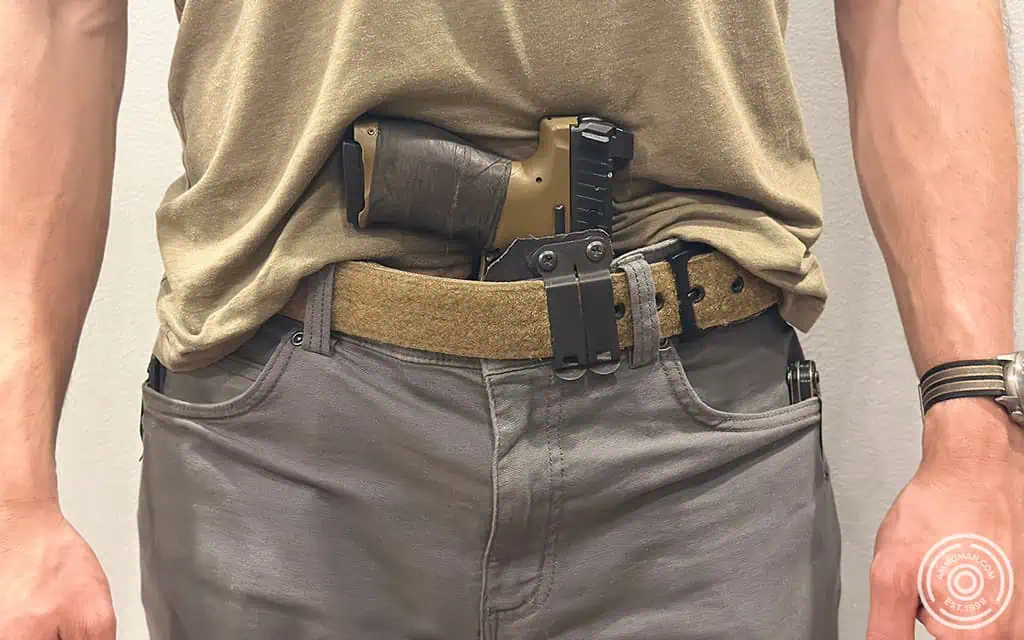
Ciguera Gear “Emmisary” gun belt.
This belt is a great balance for a daily use belt, that can also flex into a range belt if needed. There are other, better options if you only need an EDC gun belt though. We’ll talk about that more in a future write up.
Best over-the-pants Battle Belt
For those who are typically in colder weather or don’t want to bother with an inner and outer belt, a padded over-the-belt option might be the way to go! We recommend the First Spear AGB.
Best Two-Piece Battle Belt
If you’re looking for an inner/outer style belt, we think the AWS SMU Belt offers high build quality without breaking the bank.
What Type of Shooter Are You?
Okay, so we gave the easy answer, but that’s not really going to help unless you already know what you’re looking for. Like we talked about earlier, it helps to know what type of shooter you are before you decide which belt to buy.
(for comparison) A recreational shooter might visit the range for fun or to train for personal defense, while a competition shooter focuses on performance in structured events like USPSA, IPSC, or PRS.
In the same way, professional use might require someone to carry a firearm or have a belt setup as part of their occupation (ie. military, law enforcement, or security contracting). A casual/recreational shooter may or may not need as much on their belt as someone who is paid to storm beaches, serve warrants, or protect a business.
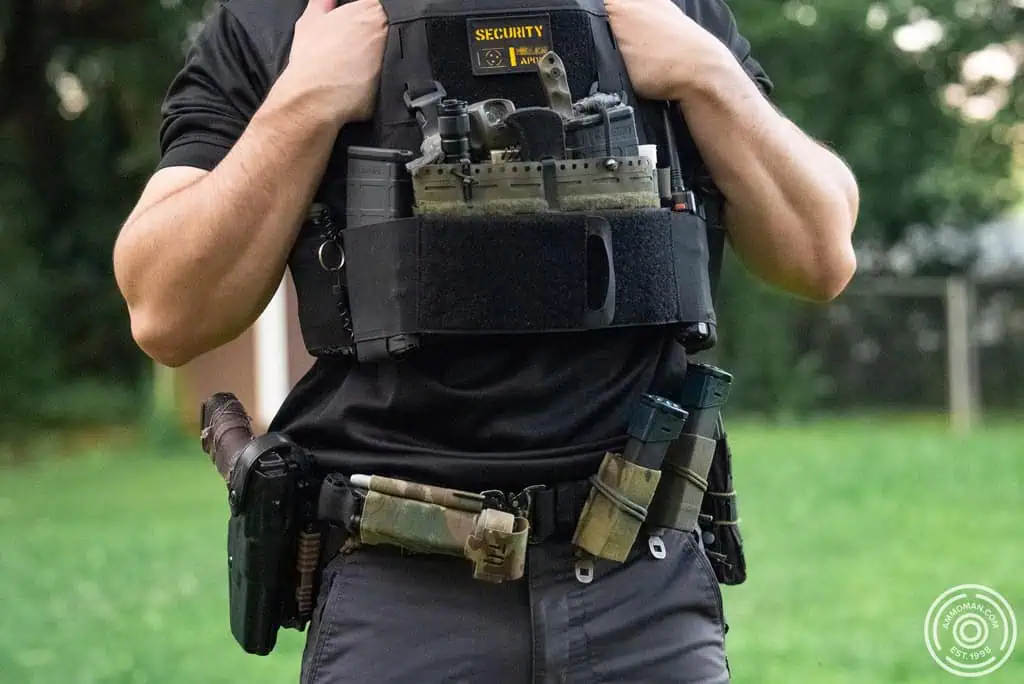
Professional battle belt setup.
Picking a Battle Belt
Taking things a step further, we are going to look into what types of belts you can pick from and help you discover what will fit you best. But before we do, we need to explain exactly a “battle belt” is!
What is a “Battle Belt”?
“Battle Belt” sounds extreme. It’s a training belt more than anything, but most people are accustomed to them being called a battle belt, or “war belt.” We think of them as a belt that can hold more than a holster and some magazines. Battle belts are able to cary all of that plus extra items you might need for a full day or multi-day training event.
Types of Battle Belts
Aside from your normal gun belt that you wear through your pants, there are two major battle belt types that you can find. There are two-piece systems, and padded outer belts. Let’s break down each option along with their pros and cons.
The Pants Belt
For the most basic setups (a few magazines and handgun), the belt you have on will generally be the cheapest and easiest route. Rigid belts for concealed carry or a thick leather belt will be able to handle what you need. Pouches with a belt pass through are the easiest to use for this, though having MOLLE straps is generally possible to get a tight enough weave around most 1.5” belts. First Spear also carries their Missing Link that works with belts that contain loop velcro on the inside.
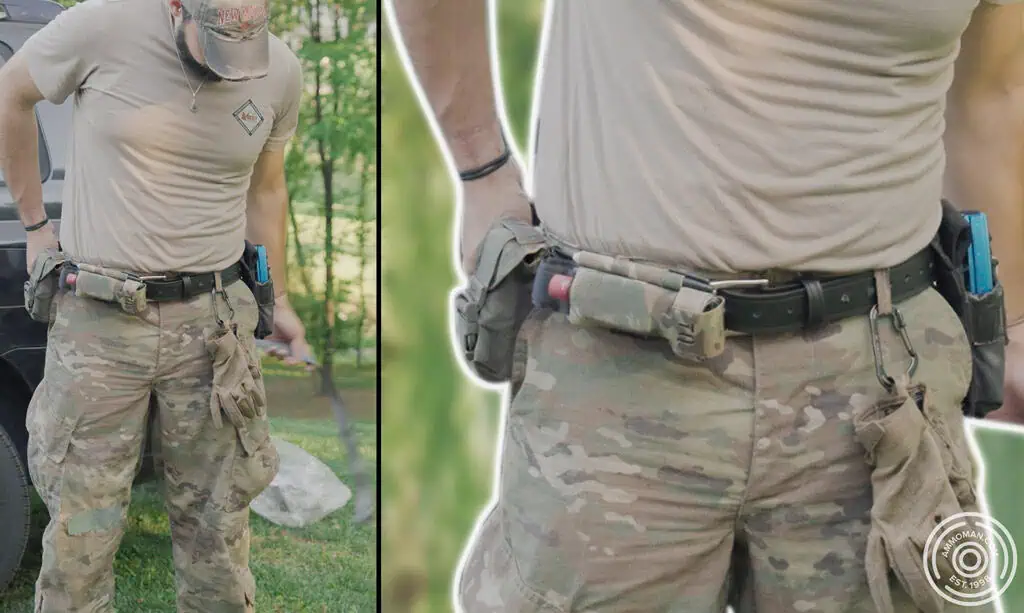
Direct mounting pouches onto a belt.
Pros:
- Cheapest Option
- Minimalist and lightweight
- Works well for when you don’t need to worry about donning and doffing your belt + gear quickly
- No need for additional equipment outside of the pouches.
Cons:
- Limited space for gear (belt loops can get in the way)
- Uncomfortable when belt becomes too heavy (weighs pants down)
- Timely setup for dry fire practice
- Difficult to get consistent placement of equipment
Some recommended options are: First Spear Line One, Ciguera Gear Emissary Belt, Kore Belts, and Blue Alpha Gear
The Inner/Outer Belt
A level up from sticking some pouches onto your belt is the inner and outer belt. This two-piece belt became popular during the Global War On Terror. Most notably with options like the Eagle Industries Operator Belt, and the AWS SMU belt. This is generally our preferred style. It can carry gear easily and maintains a relatively lightweight base with low bulk.
This is best suited if you’re looking for a dedicated belt setup with repeatable gear placement. There is also the increased ability to don and doff all of your gear quickly.
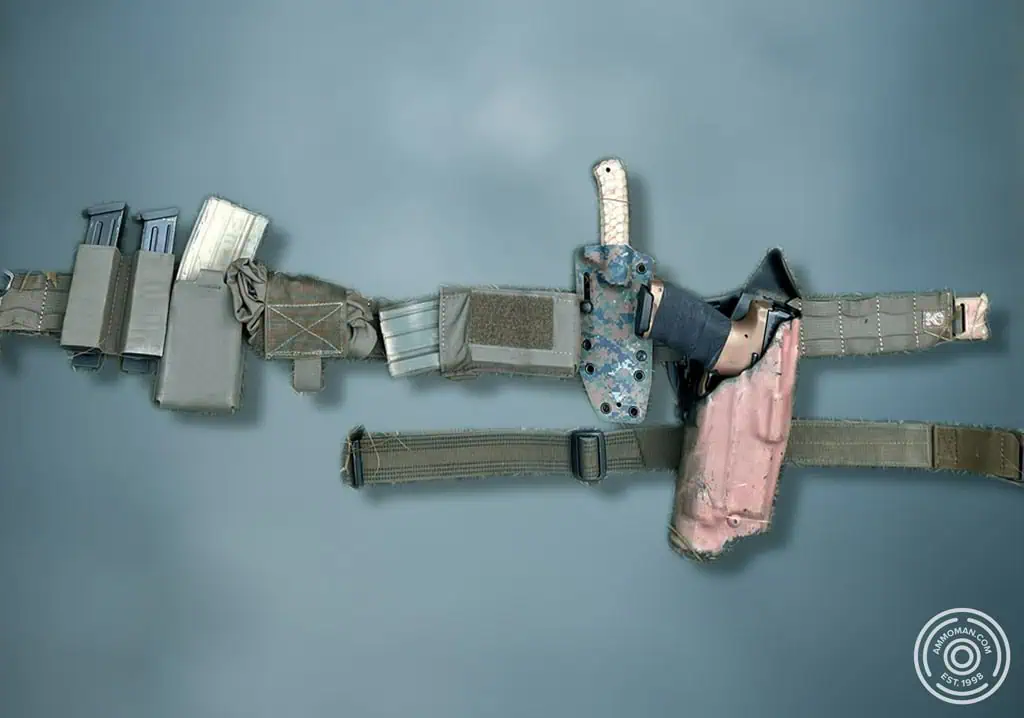
Fully assembled two-piece battle belt.
Sliding pouches onto a belt is not as easy to consistently place when compared to mounting with MOLLE webbing. The inner/outer setup does not add heat retention to your body, and is not too bulky but allows you to carry much more.
Mounting Equipment on Two-piece Belts
Because the each belt is lined with velcro, there are more mounting options for things like tourniquet/shear sleeves or IFAKs. You can also easily swap where or how it’s mounted on the fly. The inner/outer setup also can use padded inserts to make a standalone gun belt that doesn’t require adhesion to your inner belt.
This works well if you are wearing multiple layers, or want to wear it over a heavy jacket. It’s also quick to throw on for for dry fire practice at home, or in case you forget your velcro inner belt. This is personally my favorite setup as you have multiple options for wearing your belt, while remaining light weight. Suspenders can also connect to the webbing to help take some of the weight off of the hips.
Pros:
- Lightweight, low profile
- Consistent placement of gear
- No additional heat retention
Cons:
- Loud to put on and take off (velcro)
- Difficult to use in wintertime with heavier layers
- If overloaded, can be uncomfortable on hips over long periods
Additional recommended options are: Grey Ghost Gear UGF belt, Haley Strategic D3 Belt
The Padded Outer Belt
Historically, the most common form of dedicated belt for equipment is the padded outer belt.
History of the “War Belt”
Ever since the adoption of the PALS/MOLLE system in the late 90s/early 2000s, belts were coming out that were a bit taller and had thicker padding on them. Early examples were like the Blackhawk! Patrol belt that started to replace the ALICE belt system.
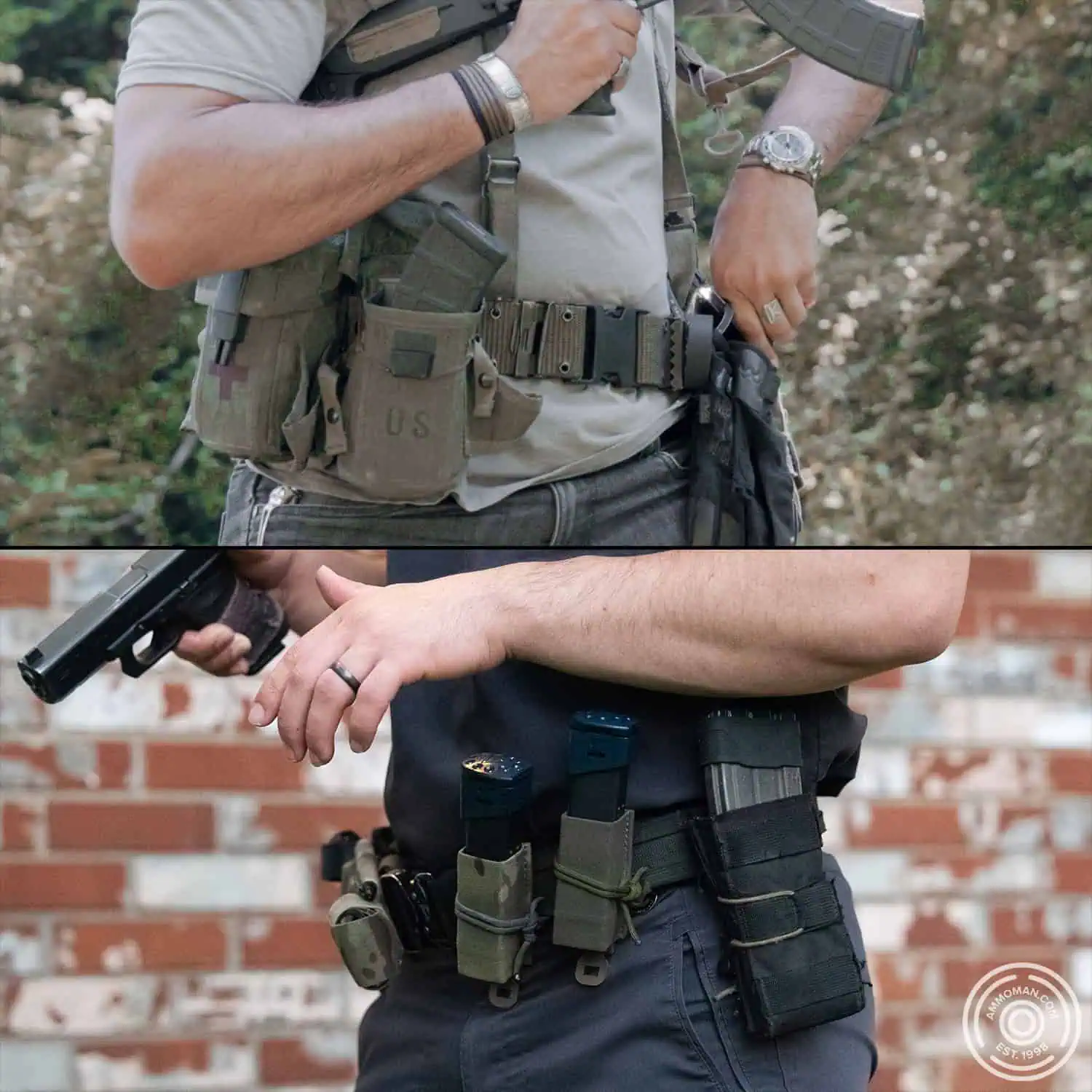
(Top) ALICE harness (Bottom) Modern two-piece belt.
Modern Padded Belts
As time and materials evolved, belts became lighter and more rigid. A lot of guys moved over to the inner/outer belt system, but the padded outer belt is still relevant! Options like the Velocity Systems Operator Utility Belt, the First Spear AGB Sleeve utilize modern materials and manufacturing processes. There are also options that integrate soft armor, to help add protection to your hips, if that’s a concern.
Best Belt for Home Defense?
These belts generally allow you to wear them over anything or absolutely nothing. This may work well for a home defense setup for that reason alone. They also often include anchor points for mounting suspenders, for carrying excess equipment.
Outer belts are generally made as either a padded sleeve that goes around a rigid gun belt, or as one complete piece. I generally prefer the sleeve since it allows for attaching holsters or direct mount pouches to the belt.
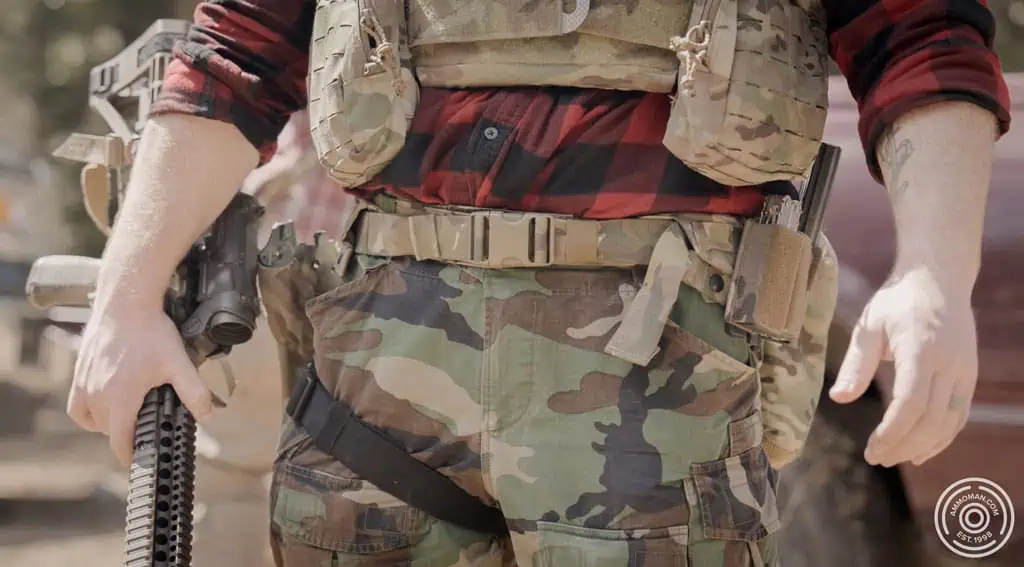
An example of a battle belt sleeve over a regular belt.
The Pros:
- Can be worn over anything
- Most comfortable over long periods of time
- Quick and easy to adjust
- Most capable of carrying heavier loads
The Cons:
- Limited manufacture options
- Heat Retention
- More difficult to attach holsters to
Recommended options: First Spear AGB Sleeve, Velocity Systems Operator Utility Belt, HSGI Laser Slim Grip Padded Belt
Determining Your Need
To figure out exactly which one of these belts will best suit you, figure out what you NEED to carry and what you’d LIKE to carry. A common setup is some variation of handgun magazines, rifle magazine(s), IFAK (Individual First Aid Kit), and holster, if desired or required.
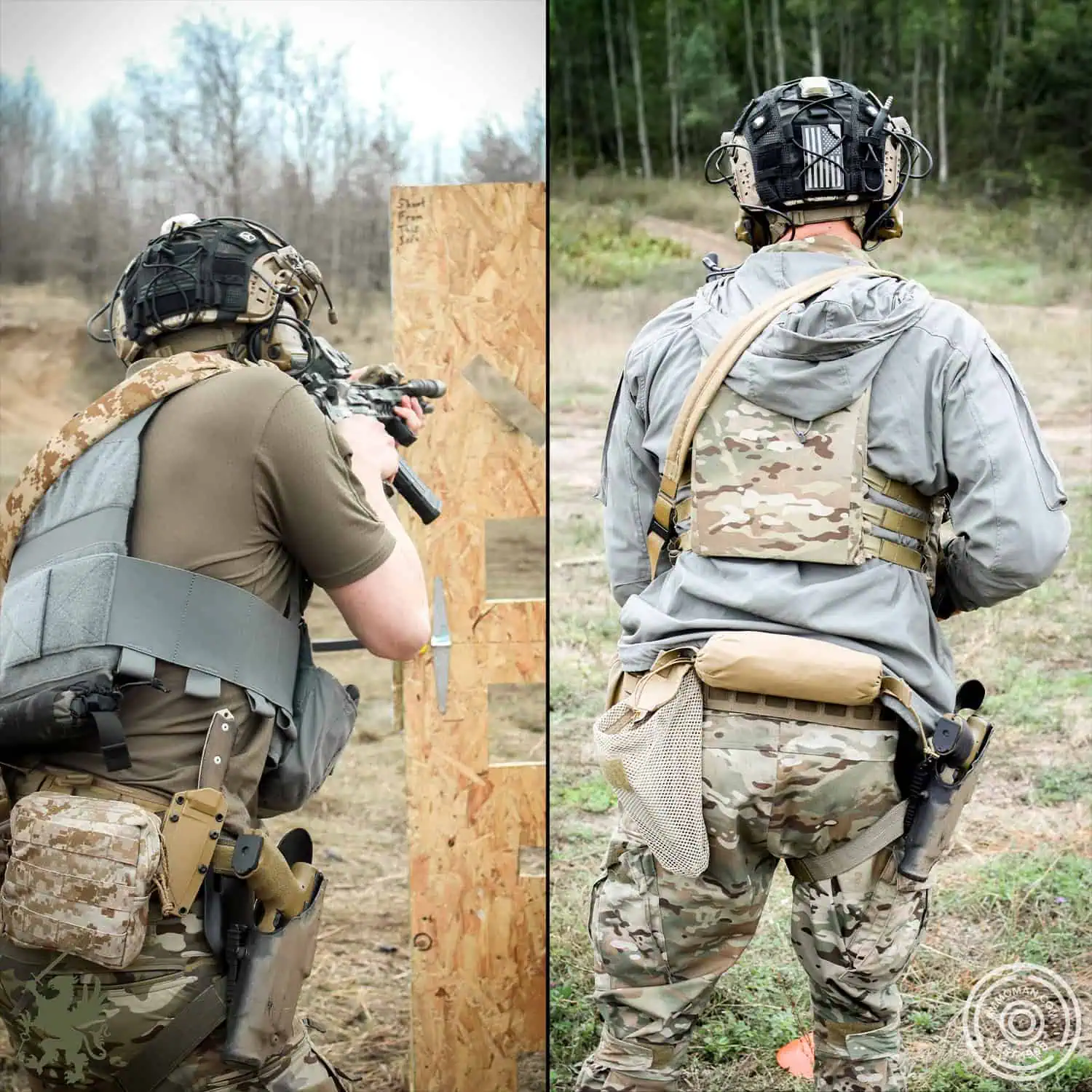
Tyler’s different battle belt setups.
Those into long range shooting may not require a handgun but will require the ability to quickly access range finders or dope cards, law enforcement need tasers or other non lethals and a way to administer aid to somebody in need. Military will require job specific tools and generally the ability to carry throwables, night vision, etc.
Start with what you need and go from there. If you have additional load bearing equipment such as a plate carrier or chest rig, this will also fuel what you require your belt to have.
Final Thoughts
There’s no certain answer to what the “best” battle belt is. It’s only what’s best for you and your needs. It should reflect your environment, role, and preferences. Don’t fall into the trap of overbuilding based on what others use. Unnecessary clutter and weight will only slow you down. Start simple, stay honest about your needs, and let real world use guide your adjustments.
As you gain experience and figure out what works and what doesn’t, your belt will evolve. The goal isn’t perfection out of the gate. It’s functionality, adaptability, and comfort! Whether preparing for a weekend match, or deploying to foreign lands, your belt should enhance your effectiveness, not hinder it.






